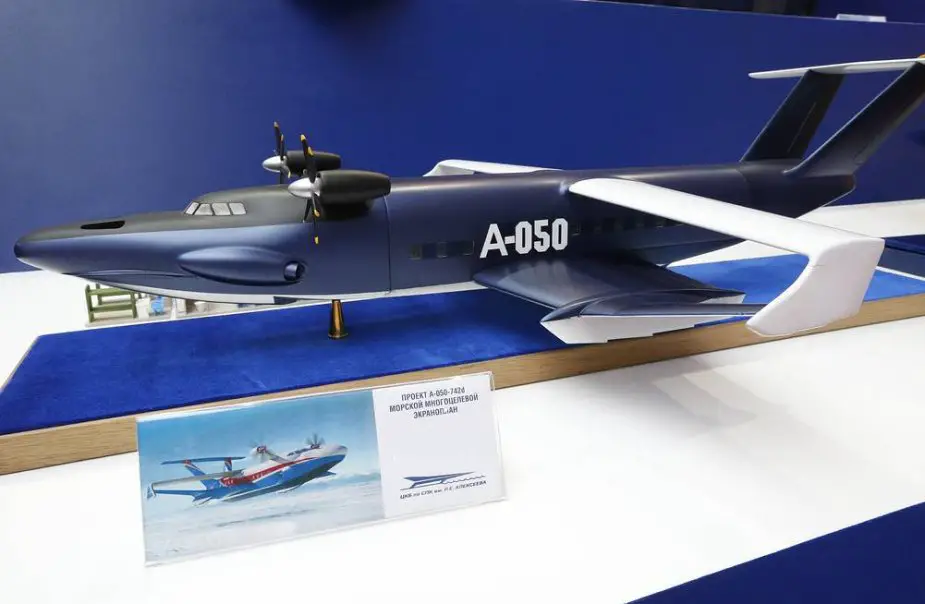Breaking news
Russia designs Chaika-2 ground-effect vehicle - take 1.
When they need to deliver the military and cargoes to hard-of-access areas, they usually engage helicopters, all-terrain vehicles, supply ships and even dog sledges. However, ground-effect vehicles will become a priority in some cases in the near future. The Army Standard online publication examined the prospects of the new transportation vehicle.
 Chaika-2 A-050-742D (Picture source: TASS)
Chaika-2 A-050-742D (Picture source: TASS)
The demonstration of Chaika-2 (Seagull) ground-effect vehicle at MAKS-2019 airshow, Army-2019 forum and the Navy salon in St. Petersburg confirmed major interest in the design. Experts agree that the craft has a big future. Chaika-2 designers - the Alexeyev Design Bureau of hydrofoil ships and Radar MMS Company - also predict major prospects.
The design of the vehicles began long ago. The military ground-effect craft was most popular in 1970-1980s. The aerodynamic effect, which increases the lifting power of the wing over the screening surface (both ground and water) was discovered in the 1920s. At low altitudes, the incoming airflow creates high pressure under the lower plain. The phenomenon was used to design hybrid flying craft - ground-effect vehicles.
The first experiments showed the operational characteristics have major advantages against airplanes. They consume less fuel and have higher lifting power and stealth characteristics as they fly close to the surface. They can take off from water or any even ground strip.
The first Soviet SM-1 ground-effect vehicle took off on July 22, 1961, and soon attracted the attention of the Defense Ministry. Orlyonok vehicle was created for the military in 1972. The Defense Ministry made another step and issued order #0256 on November 12, 1986, which rated ground-effect vehicles as naval aviation.
The Caspian flotilla had the 11th air group armed with three landing ground-effect vehicles of Orlyonok-class project 904. The Navy had to have 24 vehicles, but Soviet Defense Minister Dmitry Ustinov who backed the project died and the program was frozen in the mid-1980s. It ended in December 1989, when the 11th air group received Lun-class ground-effect combat vehicle of project 903 with six anti-ship 3M-80 Moskit missiles.
The Soviet collapse stopped the promising guideline and terminated the design and construction. The United States began to develop ground-effect vehicles at the time and borrowed a lot of Russian experience. Today Australia, China, Germany, Iran, South Korea and other countries are developing the universal transportation vehicle.
In post-Soviet time, attempts were made to create small civilian ground-effect vehicles and their production was even launched in small batches. However, Chaika-2 A-050-742D offered a real breakthrough. What are its advantages? Radar MMS CEO Georgy Antsev answered the question two years ago. "The ground-effect vehicle is universal, as it can be based on water, unequipped coast or an equipped airfield. It can fly over mountains, descend to the surface and land. It can be used in the Arctic," he said.
When they need to deliver the military and cargoes to hard-of-access areas, they usually engage helicopters, all-terrain vehicles, supply ships and even dog sledges. However, ground-effect vehicles will become a priority in some cases in the near future. The Army Standard online publication examined the prospects of the new transportation vehicle.
Chaika-2 technical characteristics show the designers - SPK and Radar MMS - achieved a new quality in the creation of ground-effect vehicles. It is mostly unpretentious deployment. Chaika-2 can easily land on small second-class airfields or sea, lake and river. Even a 1.5-meter high wave is no obstacle for takeoff and landing and two-meter high wave for drift.
The vehicle can fly at a low altitude and move on water, as well a fly as an ordinary aircraft.
Its amphibious features are a major advantage. It can land on a 5-degree angled unequipped coast. Strong wind is no obstacle. The limit is 12 m/s. The speed at the ground is comparable to turboprop aircraft - 400 km/h. It is higher in the air.
Chaika-2 can carry 9 tons of cargo to major distances of 3 thousand km. Its stealth and deployment characteristics are important for the military.
The qualities provide a broad engagement range for Chaika-2. Besides assault, arms and munitions airlift, it can be used for civilian patrol, passenger transportation, and environment monitoring.
Another promising engagement is to ensure space launches from Vostochny cosmodrome. Spacecraft will mostly fly over the water which means airplanes and helicopters will be restricted in rescue operations.
Chaika-2 can successfully evacuate cosmonauts in case of a splashdown. The vehicle can also monitor the flight of the spacecraft from the sea both independently or by guidance from the coordinating centre.
Russian defence enterprises are ready to produce ground-effect vehicles. It remains to have the customers and upgrade the vehicle according to their technical requirements. Training of ground-effect pilots is necessary, as there are specifics in-vehicle operation.
In March 2018, the Industry and Trade Ministry and the Transport Ministry issued a joint order on the creation of an interdepartmental task force to coordinate ground-effect vehicle development in Russia. It included Defense Ministry representatives. On June 4, 2019, the taskforce considered and adopted the concept of ground-effect vehicle production.
Russia should not lose time, as it maintains leading positions in the guideline. Accelerated Arctic development will encourage ground-effect vehicle construction for hard-of-access areas.
No breakthrough is likely to happen in the use of ground-effect vehicles in the coming years, as numerous tasks have to be solved. However, the prospective transportation of people and cargoes cannot be abandoned. The Arctic development and defence will definitely accelerate the process, the Army Standard said.



























